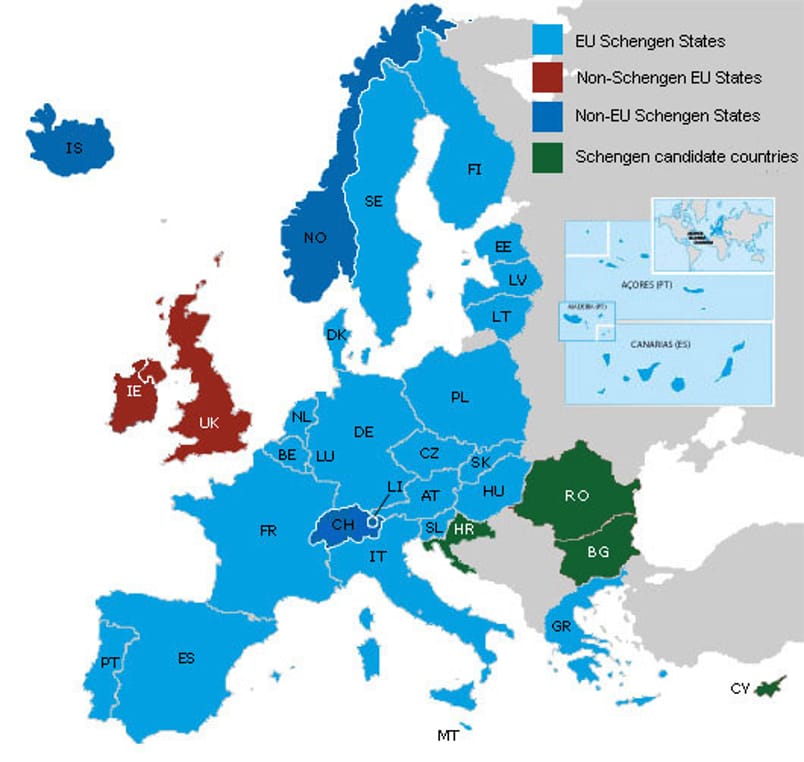Understanding the Schengen Agreement – What it Means for U.S. Citizens
Navigate Europe's Schengen Area visa-free for 90 days. Extend stays via non-Schengen countries like the UK. Essential tips for U.S. travelers.


The Facts
The Schengen Agreement was signed by five of the ten member states of the European Economic Community on 14 June 1985. It is named after the town of Schengen which was the location of the signing.
The first effects of the agreement on travelers came in 1990 with the addition of the Schengen Convention. Many U.S. travelers noticed the positive impacts on travel when they no longer had to stop at vehicle border control areas when crossing from country to country while traveling within the Schengen Area.
The number of countries participating in the Schengen Agreement has grown from the original five to 25 European countries. Travelers have their passports checked when crossing in and out of the external borders of the area, but are then free to travel within the now 1,664,911 square miles of the Schengen Area without going through passport control or showing a visa. Since 1999 the rules adopted by Schengen are now a part of the European Union law.
Most U.S. travelers abroad have had their travels made easier by the ease with which they can cross borders within the Schengen Area. But many travelers are not aware of the Agreement itself or the other ways in which their travel may be impacted.
One important thing for travelers to understand is which countries are not a part of the Schengen Area, like Ireland and the United Kingdom.
Why is this important? Under the Schengen Agreement, in theory travelers are passing from country to country under a Schengen Visa which allows free travel between these countries. However, it limits the time non-citizens of the Schengen Area can travel within the area to a maximum of 90 days within any six month period. Since for U.S. travelers a visa is not required for travel to most of the Schengen countries they are not always aware of the restrictions on travel.
With the ability to work from anywhere more and more people are choosing international lifestyles. For those people being aware of these rules becomes critical. Whether you are taking an extended European trip or making a choice to live part of each year in Europe you must abide by the rules of the Schengen Agreement unless you apply for a resident visa.
Planning Your Trip
It is still possible for U.S. travelers to spend more than 90 days in Europe with a little planning. When you exit the Schengen Area the count on your 90 days stops.
So, if you are planning to live in France for 100 days, you could stay in France for 30 days, go to the United Kingdom for a two week holiday, then return to France for an additional 60 days. It is important to remember that your 90 days does not reset when you exit and reenter the area. You are still limited to 90 days total within any 180 days period.
If you are planning an extended trip through many countries in Europe, you could extend your trip beyond 90 days by visiting non-Schengen countries along the way. From the south of Europe you could visit Turkey for a few weeks and then return to the Schengen Area. From northern Europe you could spend some time in Ireland and the United Kingdom and then return to the Schengen Area in The Netherlands.
Passport Requirements
The European countries that make up the Schengen area require that short-term tourism or business visitors’ passports be valid for at least 90 days beyond the intended date of departure from the Schengen area. Since some Schengen countries assume all travelers will stay the full 90 days allowed for visa-free visitors, many countries will not allow you entry if your passport is not good for at least six months from the date of entry.
If you are planning to stay more than 90 days in the Schengen Area in a six month period you must apply for a visa from the country where you will be staying the majority of the time. Contact the local embassy for the country you will be visiting for application requirements.
The Schengen Countries
Austria
Belgium
Czech Republic
Denmark
Estonia
Finland
France
Germany
Greece
Hungary
Iceland
Italy
Latvia
Liechtenstein
Lithuania
Luxembourg
Malta
Netherlands
Norway
Poland
Portugal
Slovak Republic
Slovenia
Spain
Sweden
Switzerland
Be sure to check with the U.S. Embassy for an updated list of Schengen countries before planning a trip of more than 90 days.




